H | Player Pics | A-Z of Players
Personal
Fullname: Samuel Henderson
aka: Sam Henderson, Sonny Henderson, Sammy Henderson
Born: 25 November 1944
Birthplace: Garngad
Signed: 23 February 1962
Left: 31 January 1968
Position: Right-Half
Debut: Celtic 1-0 Dundee United, League, 19 February 1964
Internationals: none
Biog
Sam Henderson attended St.Mungo’s Academy in Glasgow (a school that many Celtic players including Tommy McInally went to), and was the Captain of their school first eleven football side.
He was a highly-rated junior when he joined Celtic from Ashfield in February 1962. His manager at Ashfield (Louis Boyle) even rated him as a better prospect than Paddy Crerand.
The Garngad-born teenager would only go on to play two senior games for the Celtic first team with his debut coming in a 1-0 league victory over Dundee United on 19th February 1964, a match in which he showed promise but also inexperience and left gaps at the back. He played the next week too, as Celtic went on to win 2-0 v Airdrie in atrocious blizzard conditions.
As Celtic entered a golden era, the young wing-half Sam Henderson failed to force his way into the first team picture as he was competing for Bobby Murdoch’s position, an impossible task.
So in January 1968, he joined Stirling Albion for £5,000, where he stayed for a long career, and the later moved to Clydebank for £20k. At the same time, Paddy Crerand was on his way to win the European Cup with Manchester Utd a few months later.
Sadly, Sam Henderson’s playing career was ended by cartilage trouble.
He moved onto the coaching staff with Clydebank in 1976, and became their manager helping Clydebank to promotion to the top tier in 1985. This included managing & coaching a young Frank McAvennie, who was still a red head at this time before he discovered blonde hair dye.
He resigned in 1988, as outside business pressures led to him having to give up his position with the club ending a fifteen year association.
Playing Career
| APPEARANCES | LEAGUE | SCOTTISH CUP | LEAGUE CUP | EUROPE | TOTAL |
| 1962-68 | 2 | – | – | – | 2 |
| Goals | 0 | – | – | – | 0 |
Honours with Celtic
none
Pictures
Articles
Sammy Henderson – Biog
https://www.clydebankfc.co.uk/manager.php?id=6
Sammy Henderson is a significant figure in the rise of Clydebank FC in the mid-1970s through the 1980s as both a player and manager. On Celtic’s books as a youngster, Sammy spent seven years at Stirling Albion before joining up at Kilbowie in 1973.
The beginnings of the great Clydebank side were starting to come together and Sam’s final season as a player saw the club lift the Second Division Championship in 1976. Sam Immediately joined Bill Munro’s backroom staff as the club made it two successive promotions to play in the Premier League for the first time.
With the loss of Davie Cooper and Mike Larnach, Clydebank were inevitably relegated back to the first Division. After failing narrowly to return to the Premier League in the following two seasons, the Bankies began to decline a little. At the start of the 1981-82 season after an indifferent League Cup campaign, Bill Munro surprisingly handed in his resignation. Sammy Henderson immediately took over for the next game and the position was soon made permanent.
Over the next few years the Bankies were regular promotion candidates, and finally succeeded in season 1984-85 finishing as runners-up to Motherwell. Once again, life in the Premier League was tough for the Bankies but memorable victories over Rangers and Aberdeen were achieved.
The Bankies had an abysmal start to the 1987-88 season,but recovered to finish in third position in the league, but with only one promotion spot available Clydebank were never truly at the races.
This was to be Sam’s final season with the club as outside business pressures led to him having to give up his position with the club ending a fifteen year association.
Football Hall of Fame beckons
https://web.archive.org/web/20140522165215/http://www.clydebankpost.co.uk/news/roundup/articles/2010/12/16/408266-football-hall-of-fame-beckons
Published: 16 Dec 2010 13:00
Clydebank FC is inducting two of its greatest managers into its Hall of Fame.
LEGEND: Sammy Henderson
Bill Munro, who was manager from 1975 until 1982, and Sammy Henderson, who was manager from 1982 until 1988, are both revered at the club for their part in getting Clydebank FC into the Scottish Premier League during their respective reigns.
Bill’s side was promoted in 1977 and Sammy Henderson’s team reached the top flight in 1985.
Bill Abraham, Clydebank FC’s director, told the Post: “Bill Munro and Sammy Henderson had very successful periods in their team’s history – that is why they are being inducted.”
The sportman’s dinner is being held on March 12 in the Goodyear Club, Drumchapel.
Some big names have been booked to keep everyone entertained and help raise funds for the club.
Football favourite Frank McAvennie, as well as comedian Joe Camay and popular speaker Bill Copeland, will feature.
The Celtic Class of ’44: Sam Henderson – still classy at 80
By Matt Corr 25 December, 2024 No Comments
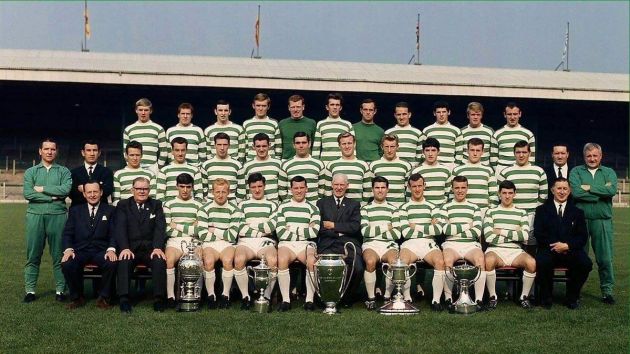
Celtic FC 1967/68
Facebook
WhatsApp
Twitter
Reddit
Email
Share
The Celtic Class of ’44: Sam Henderson – still classy at 80…
The latter half of the calendar year 1944 produced so many talented footballers who would go on to wear the colours of their boyhood club, Celtic. At that time, the club was struggling to secure any kind of success under its second manager, Jimmy McStay, with the last of his remaining teammates from that classic 1930s era – Bobby Hogg, Malky MacDonald, George Paterson, John Divers and Jimmy Delaney – all working hard to encourage the next batch of Hoops hopefuls. It was a million miles from the environment that those future players and supporters born around that time would enjoy under Jock Stein, two decades later.
The first of our Class of ’44 War Babies was Bobby Murdoch, born in Rutherglen on Thursday, 17 August, appropriately enough just 48 hours before that same Jock Stein took his place in the centre of the Albion Rovers defence to face a Celtic side blooding a 17-year-old outside-left from Glasgow who would later be up there with Bobby in discussions around who was the club’s greatest-ever player. That new Bhoy was Bobby Evans and Celts won the Southern Regional League match 1-0 thanks to a penalty kick converted by another Hoops legend, the aforementioned Delaney, whilst a third – MacDonald – was sent off for ‘the raising of fists!’
Six weeks later, the last of the unique team who would become the Lisbon Lions was born in Viewpark, Uddingston. No prizes for guessing that was Jimmy Johnstone, who arrived to light up the world on Saturday, 30 September 1944. His birth would be of no consolation to Celtic supporters that afternoon as the Hoops lost a seven-goal thriller at Cappielow with the last kick of the ball, one of Morton’s goals scored by another 1930s Parkhead great, Johnny Crum.
Tuesday of the following week saw the birth of another classy Celtic attacker, Harry Hood born in Stobhill Hospital in the north of Glasgow on 3 October. The first Celtic match of Harry’s lifetime was the Glasgow Cup final at Hampden on Saturday, 7 October 1944. Goals from Matt Lynch and debutant centre-forward Jim McKay had a Celtic side missing the injured Delaney 2-0 up with just 25 minutes to play before future Rangers managers Scot Symon and Willie Waddell levelled the match. A late George Young penalty then took the cup back to Ibrox for a fourth successive year.
The opening week of December brought another wonderful Celt and gentleman into the world, albeit tragically we lost him at the end of October. Tommy Callaghan was born in Cowdenbeath on Wednesday, 6 December 1944, and the first Celtic match of his lifetime took place at a venue where he would enjoy cup final success with both Dunfermline Athletic and his beloved Hoops, Hampden Park. Three days after Tommy’s birth, a Joe McLaughlin double gave Celtic a 2-0 victory over Queen’s Park in a Southern League fixture. As an aside, Joe is another man who would enjoy Scottish Cup final success at Hampden, in his case with Aberdeen as the Dons beat Hibernian to win the trophy for the first time in the spring of 1947.
Sadly, none of these four fabulous Celts survived to celebrate their 80th birthday, but the fifth Class of ’44 member we honour today did so just a few short weeks ago.
Samuel Joseph Henderson was born in the Garngad district of Glasgow on Saturday, 25 November 1944. That afternoon, Jimmy McStay’s Celtic suffered a fifth successive away Southern Regional League defeat, this time by 2-0 to Hearts at Tynecastle, to drop to 11th place in the 16-club Division. Desperate times indeed, but Sam’s arrival triggered a change in the fortunes of the grand old club, who would win 14 and draw the other in the remaining 15 matches of that League campaign to finish as runners-up.
Sam attended St Mungo’s Academy and his footballing prowess soon brought him to the attention of the scouts. He starred with Giffnock North Amateurs before stepping up to Junior level as a 17-year-old and by January 1962 he was turning out at inside-right for Ashfield against Cambuslang Rangers at Somervell Park in the Central League. By this time, Sam was on Celtic’s radar, with reports of him signing for the club in both February 1962 and March 1963, possibly provisional and senior call-ups respectively.
Certainly, Celtic had a number of provisional signings turning out for Ashfield in early 1962 – goalkeeper Ian Leckie, wing-half Gerry Murney and centre-forward Jim Mallan junior being three examples – and there was an inside-right known as ‘Junior’ in the Hoops reserve team which played at Dens Park on the opening Saturday in March 1962, whilst a teenage Bobby Lennox made his senior debut in the first-team fixture at Celtic Park. Was that Sam? Perhaps that is unlikely, but he was certainly back in the Ashfield side which beat Vale of Clyde 5-3 the following week at Saracen Park. I guess that’s a question for you, Sam!
Incidentally, Sam had an afternoon off on Saturday, 7 April 1962 as a Central League select beat the Irish ‘B’ League 3-2 at Firhill, Blantyre Celtic winger Jim Johnstone scoring the winning goal. Provisional Celtic signing ‘Jinky’ was farmed out to the Blantyre outfit at that time and had starred for Scotland Juniors in a 4-1 win over their Irish counterparts at Newtonards three weeks earlier, a match played, appropriately enough, on St Patrick’s Day. According to Celtic historian Pat Woods, Parkhead scout Jimmy Gribben was a keen observer of both matches, and his displays would lead to the canny Baillieston man recommending to club management that the little redhead had a bright future. How crucial that advice would prove to be.
Sam was not included in the 39-man Celtic squad (shown below) which assembled for the Public Trial on 7 August 1962. No fewer than 34 of those players took part, whilst the five Celts due to play for the Glasgow Select team against Manchester United at Hampden the following night in the Glasgow Charity Cup match – Dunky MacKay, Pat Crerand, new skipper Billy McNeill, John Hughes and John Divers – all sat this one out.
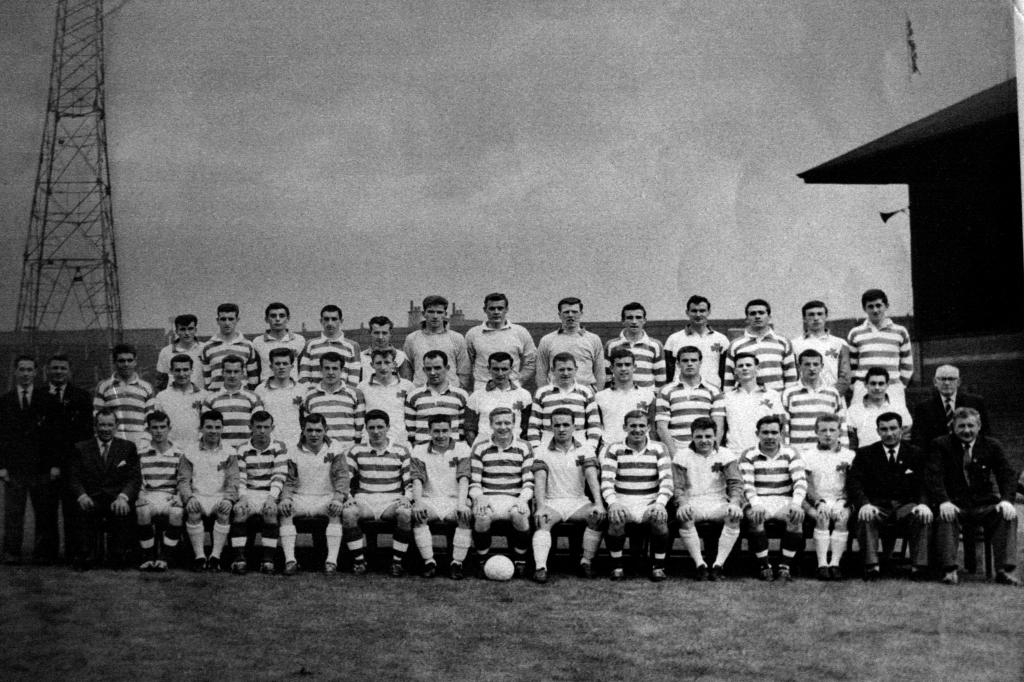
Celtic 1962. Photo The Celtic Wiki
Sam kicked-off the 1962/63 campaign in a new right-half role for Ashfield, and a report in the Evening Times of Saturday, 22 September 1962 headed ‘Ashfield have the Celtic touch’ confirms that both he and goalkeeper Ian Leckie are ‘booked for Celtic Park but will not step up until they have gained more experience with the ‘Field. The article is supported by a photograph of both players, this perhaps the first image of Sam in a national newspaper.
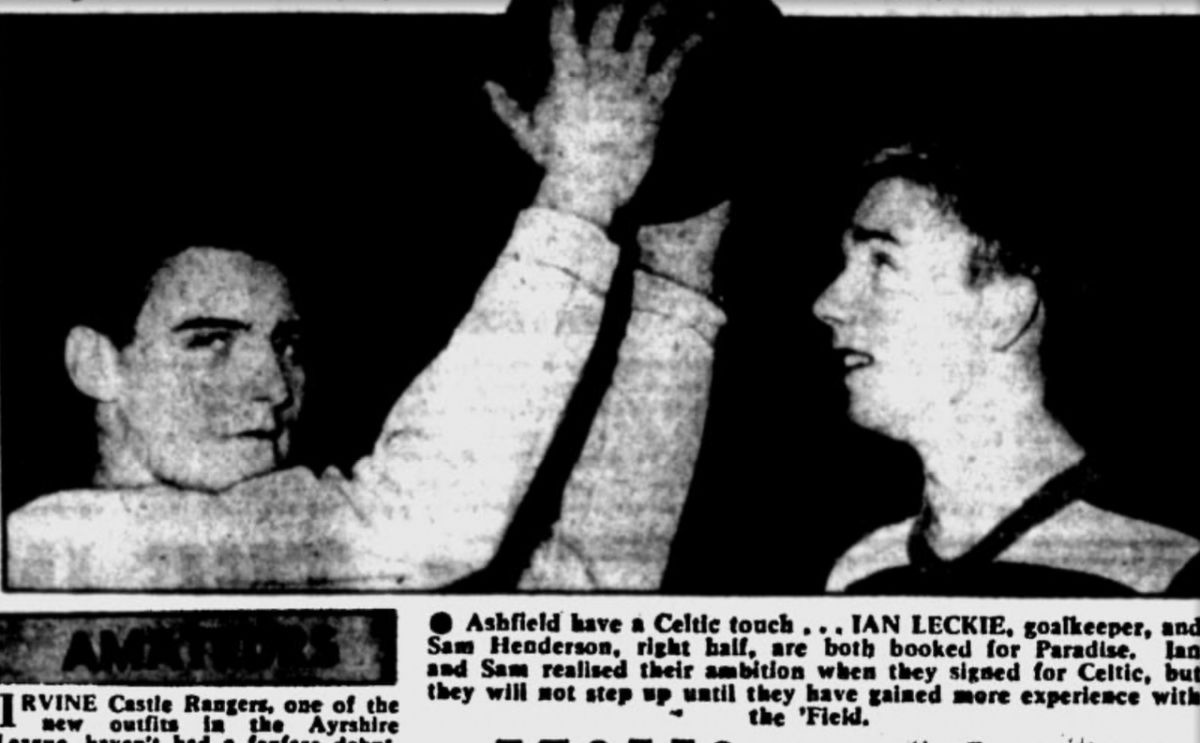
Sam Henderson & Ian Leckie. Press cutting
Sam and Ian were again featured in the Evening Times of Saturday, 26 January 1963 as Scottish football suffered from the worst winter weather in memory. The article was headed ‘Two New Celts’ and provided some context on the current situation with another photo of both youngsters.
“Heading for Paradise are these teenage Ashfield players, goalkeeper IAN LECKIE (left) and right half SAM HENDERSON. Celtic have them signed provisionally but they will be left with the ‘Field while they are interested in the Scottish Cup.
Ian, who joined Ashfield from Tradeston Holmlea, is serving his time as a Lift Engineer, while Sam is an Apprentice Chartered Accountant. He formerly played for Giffnock North.”
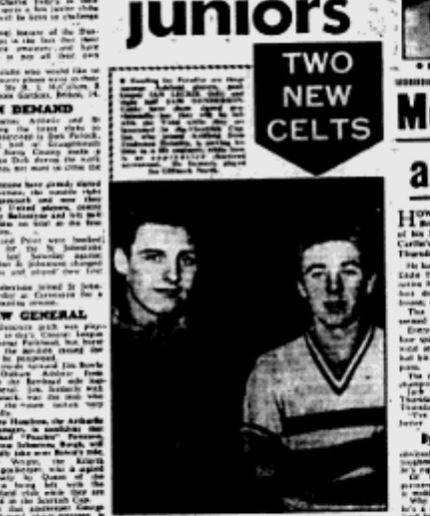
Sam Henderson & Ian Leckie. Press cutting
Sam was a member of the successful Saracen Park squad which won the Glasgow Junior Cup and the Glasgow Dryburgh Cup in 1962/63 but as the above article had suggested, his time at Ashfield ended with their elimination from the Scottish Junior Cup. That cup exit took place at Cumnock’s Townhead Park on Saturday, 16 March 1963, with Ashfield losing 2-0.
On the same afternoon, Scotland’s Juniors drew 1-1 with Ireland at Firhill, Sam’s manager clearly at a loss as to why he and teammate Jimmy Mallan – the son of the Celt of the same name – were not selected.
The Evening Times that day went with an article headed ‘Mallan Magic.’
“Clyde are the latest club to make inquiries about sharp-shooting Jimmy Mallan, the Ashfield centre forward. Jimmy scored a hat-trick in the Scottish Cup tie against Thorniewood United – one of the goals was from fully 30 yards’ range. Ashfield just can’t understand why Jimmy and right half Sam Henderson were not considered for the junior international against Ireland.
Sam is booked for Celtic, and Louis Boyle, the Saracen team boss, told me he feels the right half is an even better senior proposition than Pat Crerand when he joined Celtic.”
To put some context around that remark, Crerand had moved to Old Trafford from Parkhead the previous month for a record Scottish transfer fee, following a disagreement during the Ne’erday game at Ibrox. And as an aside, the Irish goalkeeper at Firhill that afternoon was Liam McFaul, who would make his name with Newcastle United.
In any case, Scotland’s loss would be Celtic’s gain, albeit Sam did not move immediately from Saracen Park. Four days after the defeat at Cumnock, the Evening Times reported…
“There is no word about Celtic calling up the three Ashfield players they signed earlier in the season on provisional forms. The players are goalkeeper Ian Leckie, right back Mike McCluskie and right half Sam Henderson. This suits the Ashfield, because, although they are out of the Scottish Junior Cup, they are still going strong in other major competitions.”
But by the end of the month Sam was indeed wearing the green and white of Celtic. On Friday, 29 March 1963, he made what I believe to be his Hoops debut in the Reserve League fixture with Partick Thistle, the young Celts winning 7-3 with the new Bhoy catching the eye. The Daily Record captured the occasion under the heading ‘Gallagher hits hat-trick.’
“Celtic boosted their prospects of the Reserve League Championship with an easy win over Partick Thistle at Celtic Park last night, although the Jags finished the game with injured Joe Hogan in the pavilion.
While Charlie Gallagher’s hat-trick was a highlight, one of the brightest aspects of Celtic’s success was the brilliant display at right half of young Henderson.”
The full Celtic side as Sam made the headlines was as follows.
Dick Madden; Ian Young & Tommy Gemmell;
Sam Henderson, John Cushley & Jim Brogan;
Mike Jackson, Bobby Lennox, John Veitch, Charlie Gallagher & Brady.
The Thistle half-back line that night was Martin Ferguson, Dick Staite and Hugh Tinney. Ferguson is the younger brother of Alex, whilst Dick Staite played alongside Harry Hood at Clyde for years and Tinney lined up with Harry for Scotland on the summer tour of 1967.
Just two nights earlier, Dick Madden, John Cushley and Jimmy Johnstone had made their senior Celtic debuts in an injury-ravaged Hoops side which lost 6-0 to title-chasing Kilmarnock at Rugby Park. With Celtic’s Reserve side also in action back in Glasgow – a 1-1 League draw with closest rivals Dundee – it is entirely possible that Sam also made a Hoops debut that evening. Another one for you, Sam!
As an aside, all three Rugby Park would have very different careers at Celtic. Dick Madden was another Class of ’44 graduate, born a few weeks before fellow Our Lady’s High School, Motherwell teammate Bobby Murdoch on Thursday, 27 July. He would not make another senior appearance for Celtic but did so for both Albion Rovers and Clydebank. John Cushley spent several years as understudy to Billy McNeill – incredibly both of those Celts also attended Our Lady’s High – before joining West Ham United in the aftermath of Lisbon. And despite some brief associations with teams such as Sheffield United and Dundee, Jinky effectively spent his professional career at Celtic, winning all of the major honours before being voted the club’s greatest-ever player in 2002.
Having left an Ashfield side in trophy-winning mode, Sam would continue in that vein at Celtic Park, the Hoops enjoying a Reserve League title triumph that spring by finishing 15 points clear of Dundee with an incredible 64 from a possible 68 points tally. Only Kilmarnock, with a 5-3 win at Rugby Park on 6 October 1962, managed to beat the young Celts, whilst both Dundee and Motherwell earned a draw at Celtic Park. The remaining 31 matches were all won, and remarkably 17 of the 34 fixtures were played in the final two months of the campaign, after Sam had been called up by Celtic.
The Parkhead colts did not enjoy the same success in the cups. A strong Rangers XI retained the Reserve League Cup with a 2-0 win at Celtic Park on Monday, 15 April 1963, thanks to a first-half double from another youngster born in the Garngad, Jim Forrest. Sam would create quite an impression on the 19,000 crowd though, with the Daily Record reporting “For Celtic, Henderson had a fine game at wing-half.”
And the Second XI Cup journey ended with a 3-2 defeat at Tynecastle in the semi-final on Tuesday, 7 May. In the previous round, over 10,000 spectators rolled up to watch Celts beat Morton 3-0 in a replay on Tuesday, 23 April, an added attraction being the sale of tickets for the forthcoming Scottish Cup final clash with Rangers. The Hoops side included future Lions John Fallon, Jimmy Johnstone, John Hughes, Charlie Gallagher, and Bobby Lennox, the latter duo sharing the goals between them. But once again it was Sam catching the eye, Jimmy Dunbar of the Evening Times commenting “I also liked Henderson, Celtic’s right-half recruit from Ashfield.”
For some reason, Sam did not appear in the Celtic squad photo for 1963/64 but he did make two first-team appearances in that League campaign, both in February 1964. Those were heady times both on and off the field, with Beatlemania at its peak on both sides of the Atlantic. Sam made his Celtic debut on Wednesday, 19 February in a home League game with Dundee United. He replaced John Clark at right-half, one of three injury-enforced changes from the 4-1 win over Airdrieonians in the third round of the Scottish Cup four days earlier, a victory achieved with a line-up which would be immortalised in song, as follows;
“There’s Fallon, Young and Gemmell, who proudly wear the green,
There’s Clark, McNeill and Kennedy, the best you’ve ever seen.
Jim Johnstone, Murdoch, Chalmers, John Divers and John Hughes,
And 60,000 Celtic fans who proudly sing the news.
Aye it’s Celtic, Celtic, that’s the team for me…”
Goals from Stevie Chalmers, Bobby Murdoch, Jimmy Johnstone and John Hughes had taken Celtic into the quarter-final, where they would be drawn to face Rangers in a repeat of the previous season’s final, this one scheduled for Ibrox. Former Celt Jimmy Rowan had briefly given the Diamonds hope at 2-1 early in the second half.
Elsewhere, future Lions Joe McBride (with a hat-trick) and Willie Wallace were both on target as Motherwell and Hearts shared six goals at Fir Park, whilst struggling Second Division outfit Ayr United caused the shock of the day by beating Aberdeen 2-1 at Pittodrie to join the big guns in the last eight.
As that Scottish Cup action was unfolding on the Saturday, Sam was in his usual place at right-half for Celtic’s Reserves as they took on Dundee United’s second-string at Tannadice. That reserve side featured Celtic names very familiar to this day, Frank Haffey, Dunky MacKay, Jim Brogan, Charlie Gallagher and Bobby Lennox, the only goal of the game coming from young centre-forward Tommy Spencer after 20 minutes.
For the midweek clash of the senior teams, in addition to Sam replacing John Clark, Paddy Turner and Frank Brogan came in for Bobby Murdoch and John Hughes, the full Hoops line-up on a very special day being as follows.
John Fallon; Ian Young & Tommy Gemmell;
Sam Henderson, Billy McNeill & Jim Kennedy;
Jimmy Johnstone, Paddy Turner, Stevie Chalmers, John Divers & Frank Brogan.
Celtic won 1-0 with a headed goal on the half-hour from Stevie Chalmers, another former Ashfield star who had been born in the Garngad.
Sam’s second and final senior Celtic appearance arrived just three days later, Saturday, 22 February 1964, as the Hoops once again took on Airdrieonians, this time in a League match at a snowbound Broomfield. Charlie Gallagher for Jimmy Johnstone was the only line-up change as Sam kept his 100% record intact, Celtic winning 2-0 thanks to a Frank Brogan double. (Stevie Chalmers was given the credit for the first goal in the Evening Times match report).
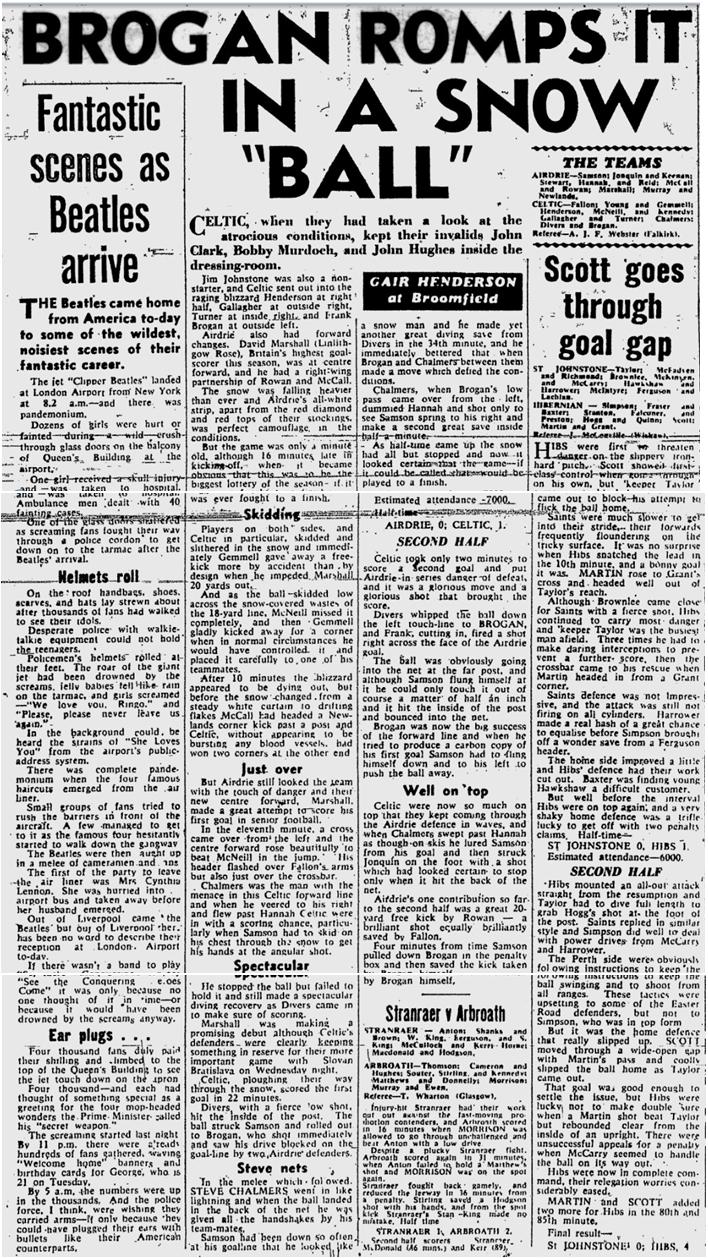
Evening Times Match report for Sam’s second and final Celtic appearance in February 1964
Sadly, Sam suffered a cartilage injury in that match which would keep him out of football for six long months and severely hindered his progression at Celtic Park, but he remains the last part-time player to feature in Celtic’s first team. John Clark returned to the first team for the midweek home clash with Slovan Bratislava in the European Cup-Winners’ Cup quarter-final.
Sam appeared in the Celtic team photo for 1964/65, seated between future Lisbon Lions Stevie Chalmers and captain Billy McNeill and wearing the iconic Shamrock kit.
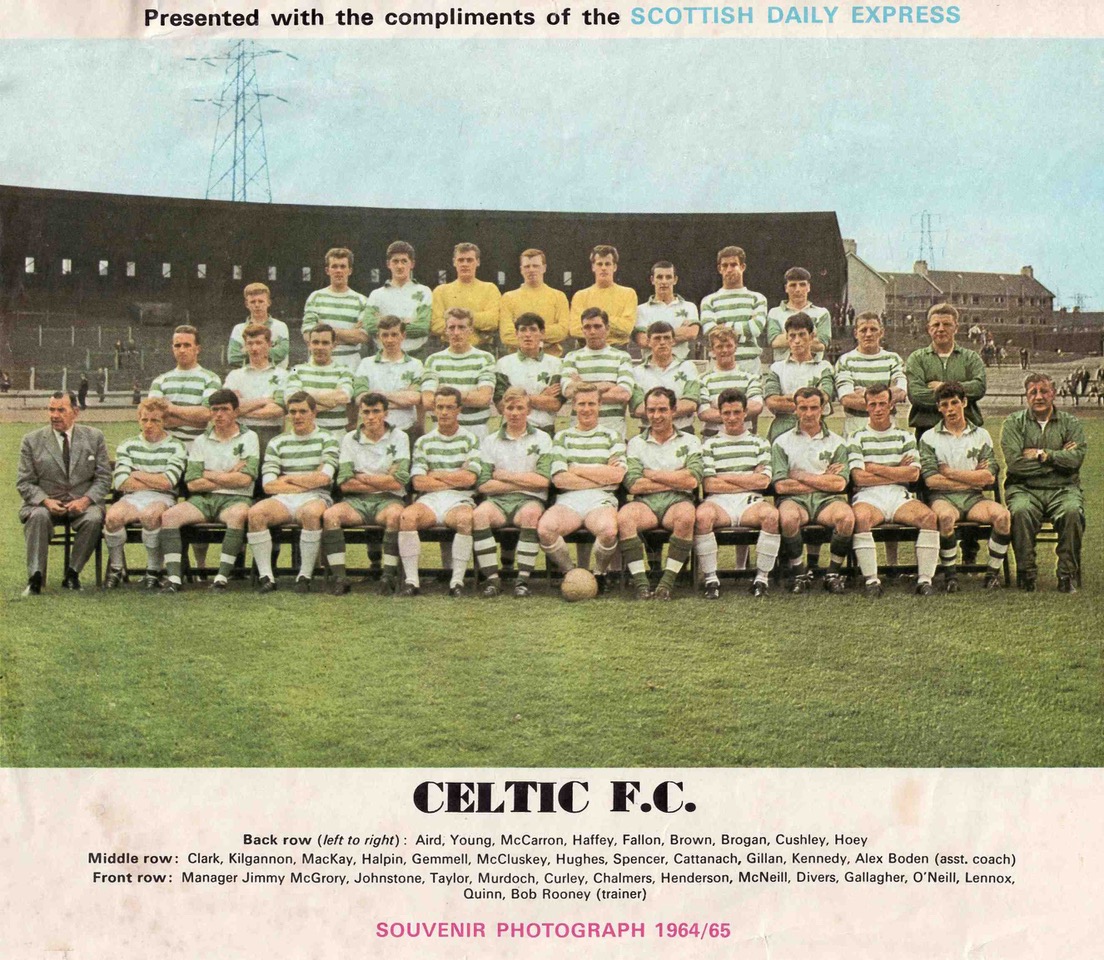
Celtic FC 1964/65
He would wear that same kit in the public trial of Saturday, 1 August 1964, whilst earning favourable reviews. The photo below shows Sam lining up for that match in a ‘Whites’ team which featured first-team regulars John Hughes – about to start a one-week suspension – and John Divers. Standing on the top right of that photo is a youthful Kenny Aird, who made his name with St Johnstone and Hearts and who sadly passed away recently, whilst the outside-left for the Whites was listed as ‘Junior’ but is possibly Tony Taylor.
The teams were as follows, and whilst Jock Stein had other matters on his mind that afternoon – his Hibernian side were facing Aberdeen at Pittodrie in the first leg of the Summer Cup final – I found it really interesting that the nucleus of the team which would achieve European glory under him was taking shape fully three years before that historic triumph.
Green and Whites
John Fallon, Ian Young & Tommy Gemmell;
John Clark, Billy McNeill & Jim Kennedy;
Jimmy Johnstone, Bobby Murdoch, Steve Chalmers, Charlie Gallagher & Bobby Lennox.
Whites
Frank Haffey, Dunky MacKay & Willie O’Neill;
Sam Henderson, John Cushley & Davie Cattenach;
John Hughes, Tommy Curley, Tommy Spencer, John Divers & Junior.
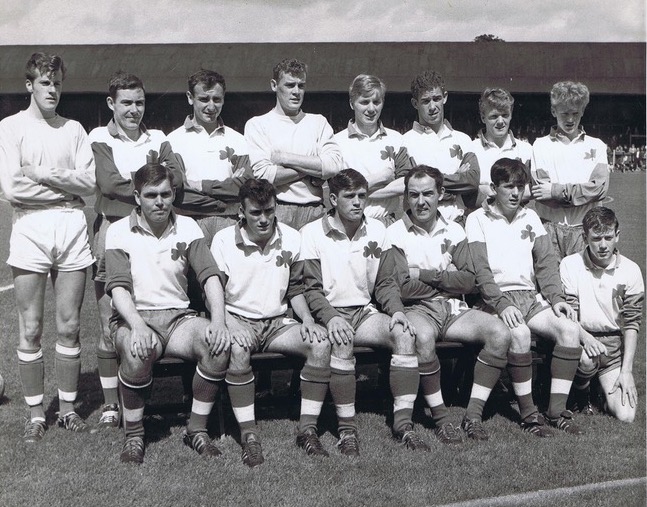
Back; David Brown, Dunky MacKay, Willie O’Neill, Frank Haffey, Sam Henderson, John Cushley, Davie Cattenach & Kenny Aird;
Front; John Hughes, Tommy Curley, Tommy Spencer, John Divers, Tony Taylor & Joey Hoey?
A double from Bobby Lennox and goals from Bobby Murdoch and Charlie Gallagher saw the first-team regulars comfortably win 4-1, Willie O’Neill pulling one back for the reserves. The Evening Times reported that “Henderson, the former Ashfield right half, was putting in some good work and one of his passes sent Hughes scurrying towards Fallon before Gemmell nipped in smartly and passed the ball back to his goalkeeper,” following that up on the Monday with, “The display of young right half Sam Henderson handed out a warning to the first-team men that, before long, he will be knocking on the door for promotion.”
Sam would also feature in the second public trial, played three days later on Tuesday, 4 August 1964. He featured in all three half-hour segments for the Whites in their 1-0 defeat on an evening where his teammates include two different forwards named Jimmy Quinn. One will be familiar as the grandson of the Croy legend of the same name, whilst the other was a trialist from Salford. Bobby Murdoch scored the only goal of the night.
Despite such early promise, Sam would not get another competitive first-team opportunity at Celtic Park. The arrival of Jock Stein as manager in March 1965 kicked off the Celtic Rising, turning the Parkhead outfit from Scottish also-rans to European heavyweights in two years.
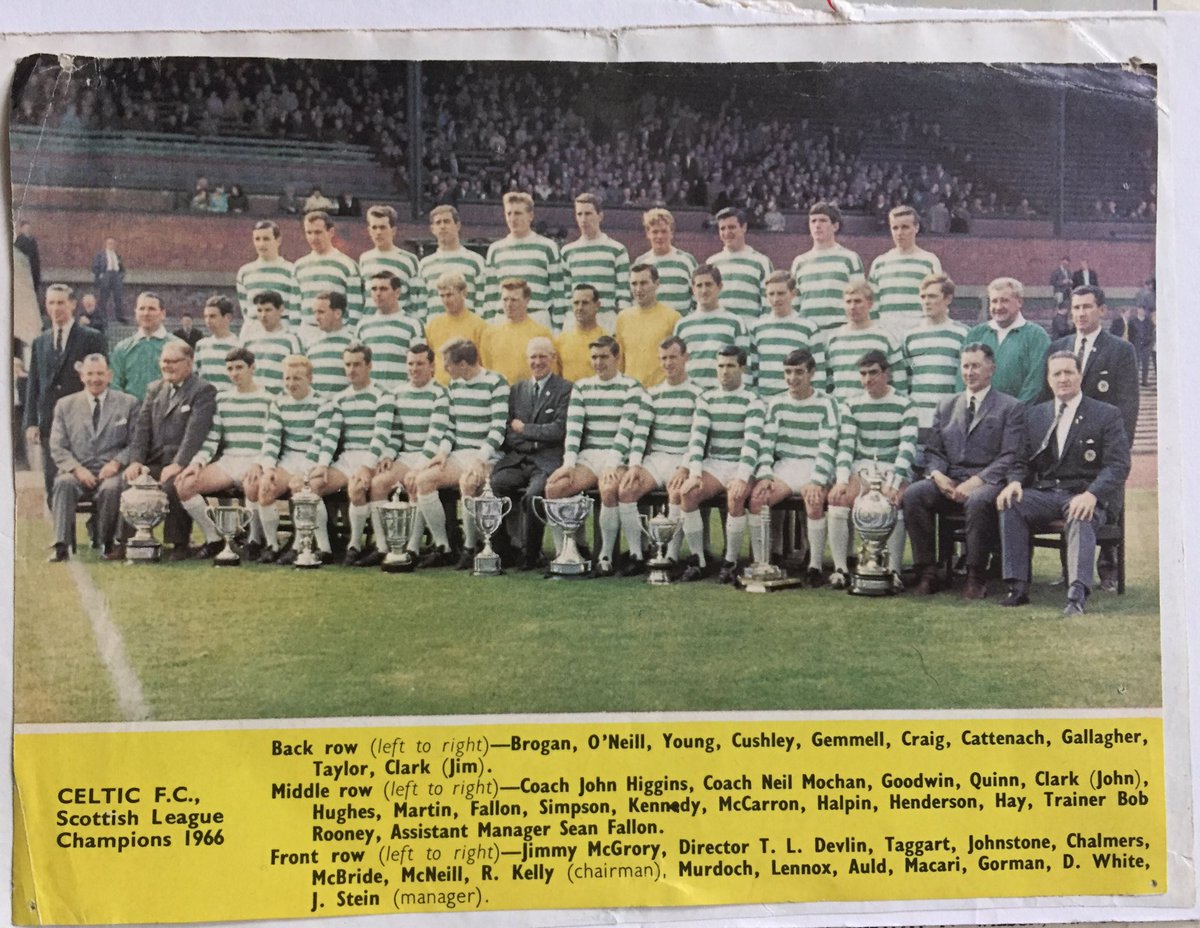
Celtic FC 1966/67
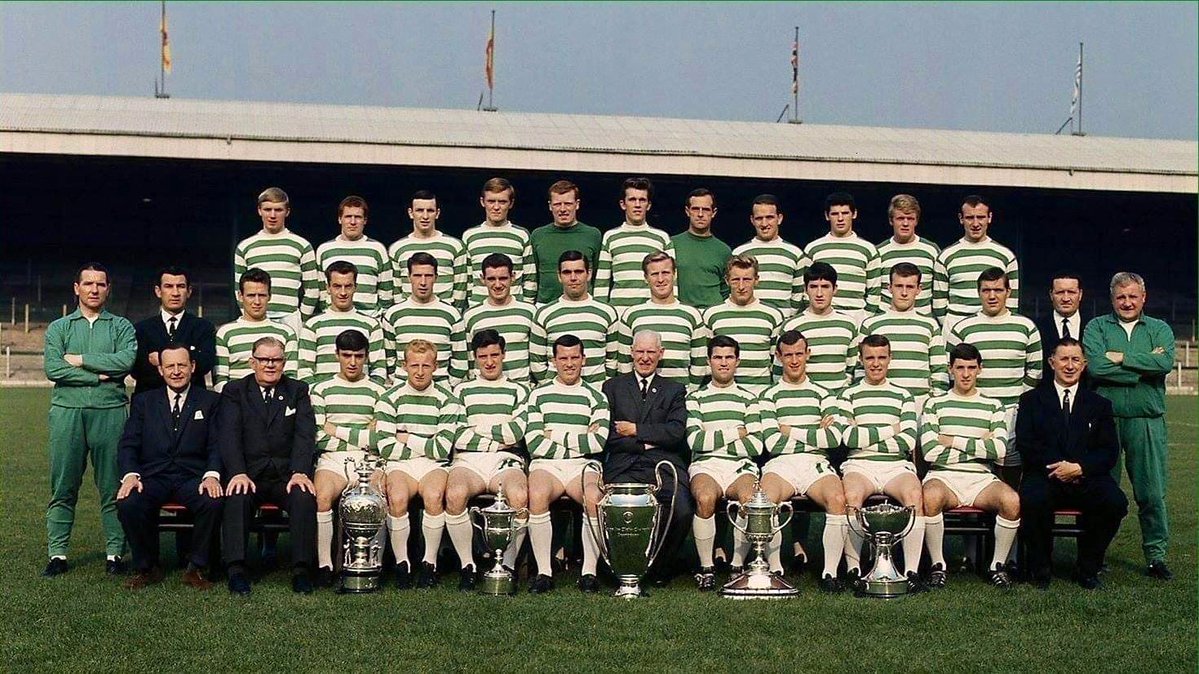
Celtic FC 1967/68
The summer of 1967 would see the addition of another batch of top-class youngsters to the Celtic squad, including future world-class stars Danny McGrain and Kenny Dalglish.
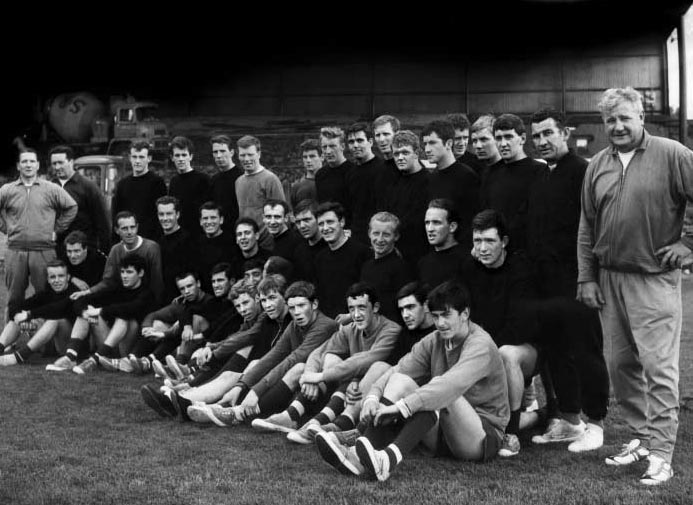
Celtic training 1967
Seeking the prospect of regular first-team football, 23-year-old Sam joined Stirling Albion on 31 January 1968 for £5,000. Just five days earlier, he had played for Celtic in a 4-0 Reserve League win over Albion’s second-string side at Annfield. The Hoops line-up for that final game of Sam’s Celtic career was as follows;
John Fallon; Jim Craig & Willie O’Neill;
Sam Henderson, George Connelly & David Hay;
Vic Davidson, Charlie Gallagher, Jimmy Quinn, Pat McMahon & Lou Macari.
And just two weeks later, Sam was back at Celtic Park, this time in the colours of Stirling Albion as they went down 2-0 to a Jock Stein team fighting to retain their Scottish title. Celts would duly do so by just two points whilst Sam’s new side sadly dropped out of the top-flight. He would later face his old teammates at Annfield with Albion in the League Cup sectional match of August 1972, on the afternoon Jock Stein waded into the crowd to confront supporters.
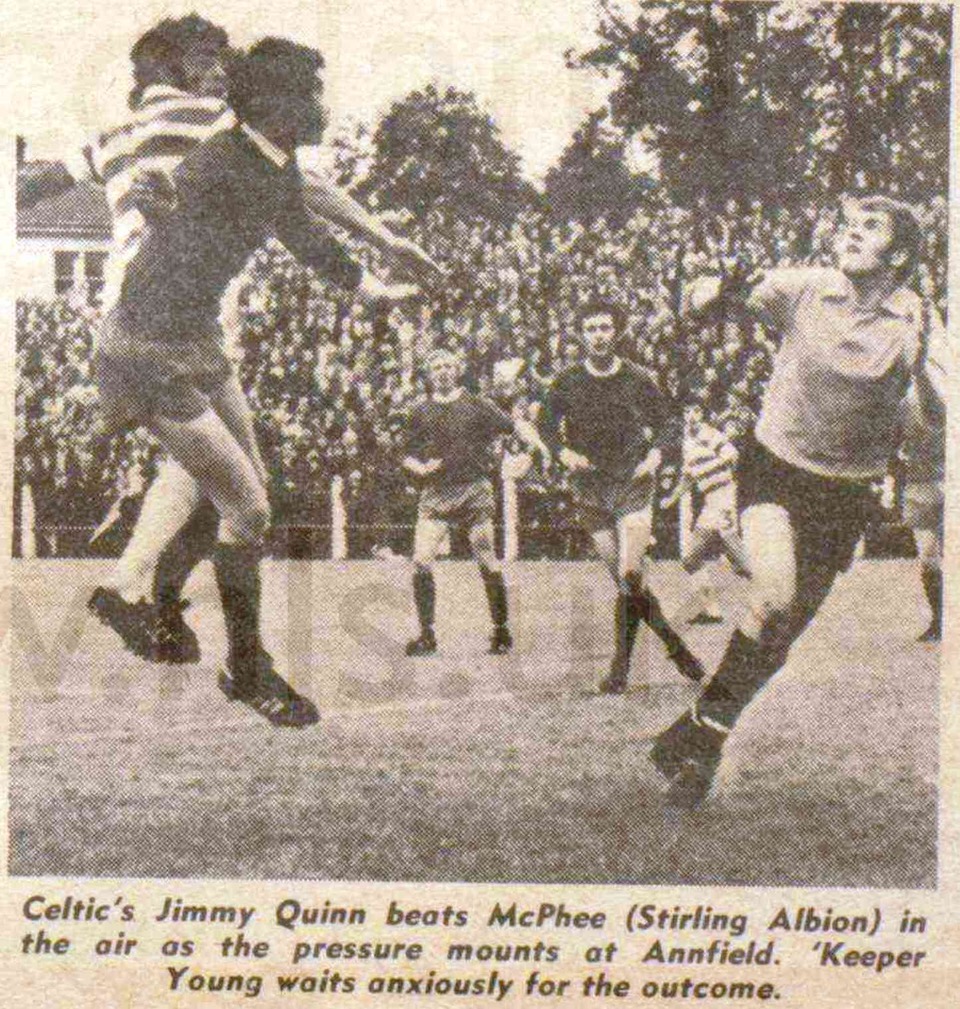
Stirling Albion v Celtic August 1972 with Sam in background.
Sam scored eight goals in his 159 appearances for Stirling Albion, before joining Clydebank on 9 May 1973 for £20,000. Once again, he would face his former Celtic colleagues, this time in the first-ever Sunday fixture, a Scottish Cup tie in January 1974, when one of his teammates was future Scotland manager Andy Roxburgh.
Insert photo from that Clydebank match of January 1974
Sam managed a further three goals in his 73 games at New Kilbowie before becoming a coach there in 1976, after a cartilage problem put an end to his playing career at the promotion-winning Bankies. In his first season as a coach, Bill Munro’s exciting young side achieved a second successive promotion to reach the Scottish Premier League for the first time.
Sammy succeeded Munro as the manager of Clydebank in the summer of 1981 and achieved promotion back to the top-flight of Scottish football in that role four years later. He remained in post until his resignation due to work pressures on 12 May 1988 and he was inducted into the Kilbowie club’s Hall of Fame in March 2011.
Off the field, the highlight for Sammy would be when he married his sweetheart Patsy Jones in Glasgow in 1969. It was my pleasure to host Sammy and Patsy on a Celtic Park stadium tour two years ago. A real gentleman, who was very humble about his achievements in the game.
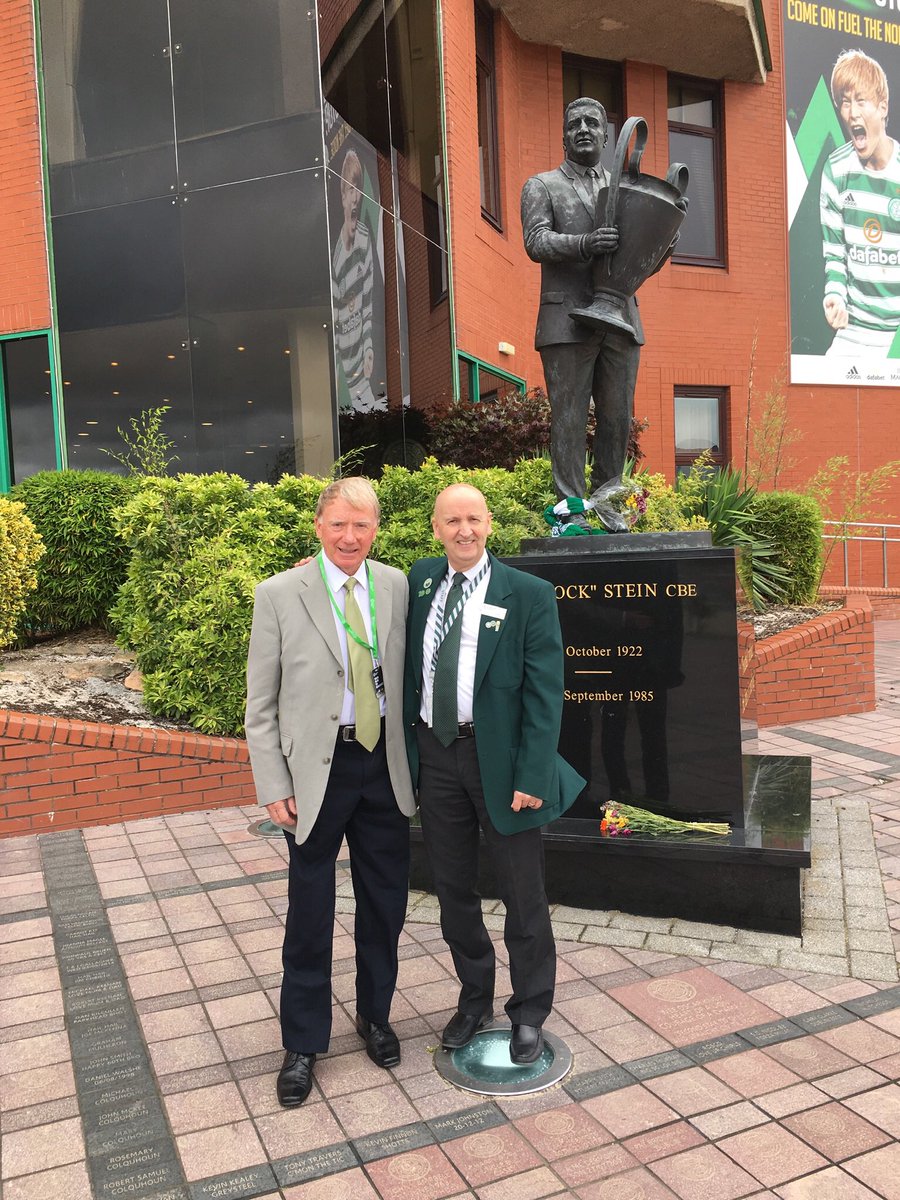
Still looking fit and classy at 80.
Have a lovely Christmas, Sam Henderson of the Celtic.
Hail, Hail!
Matt Corr